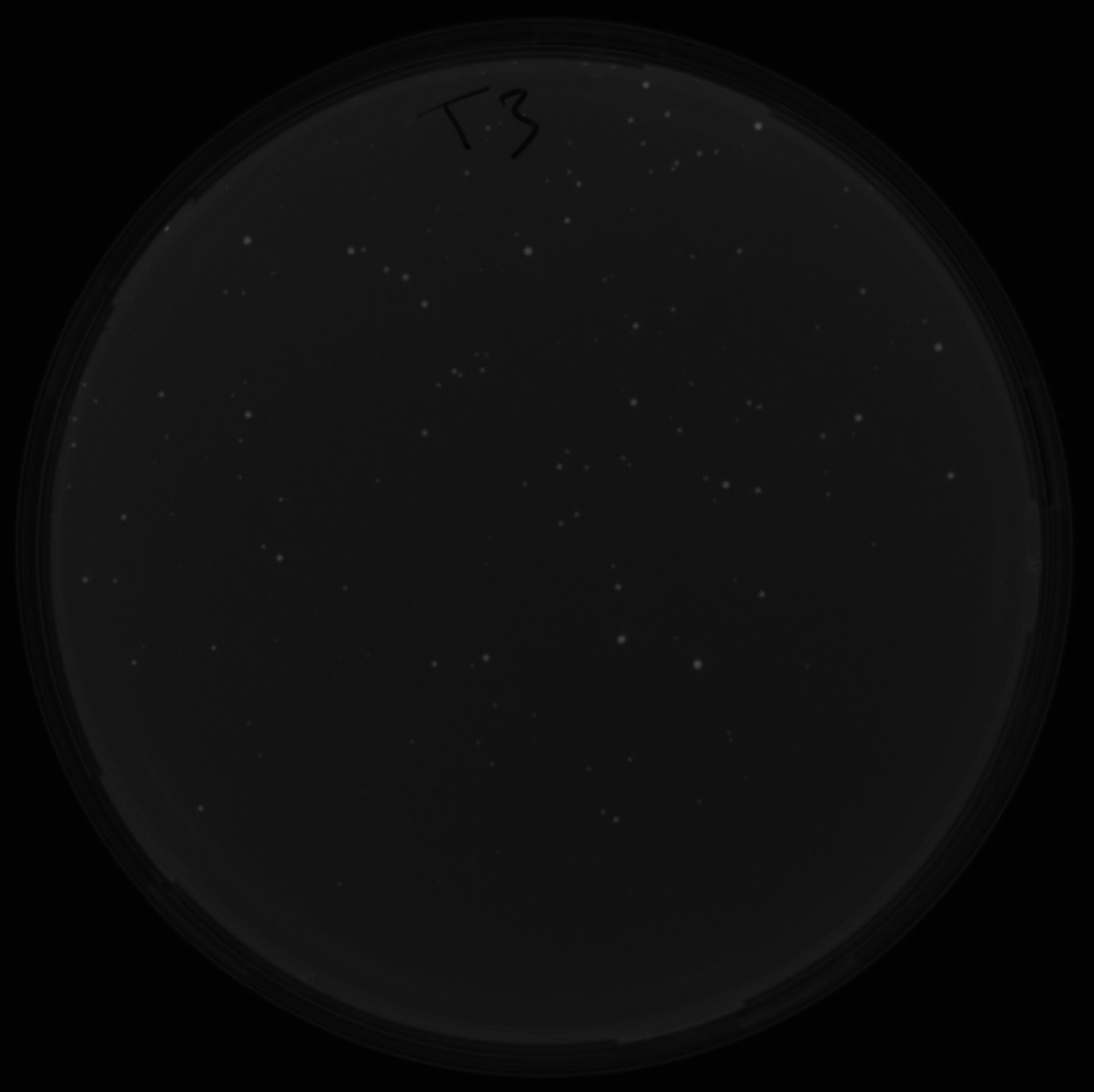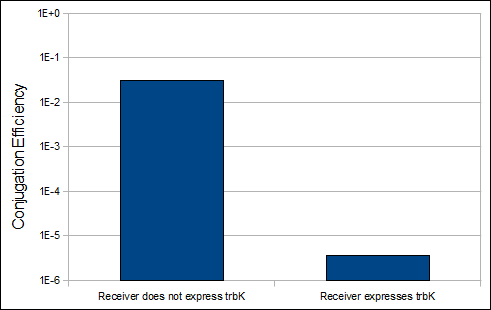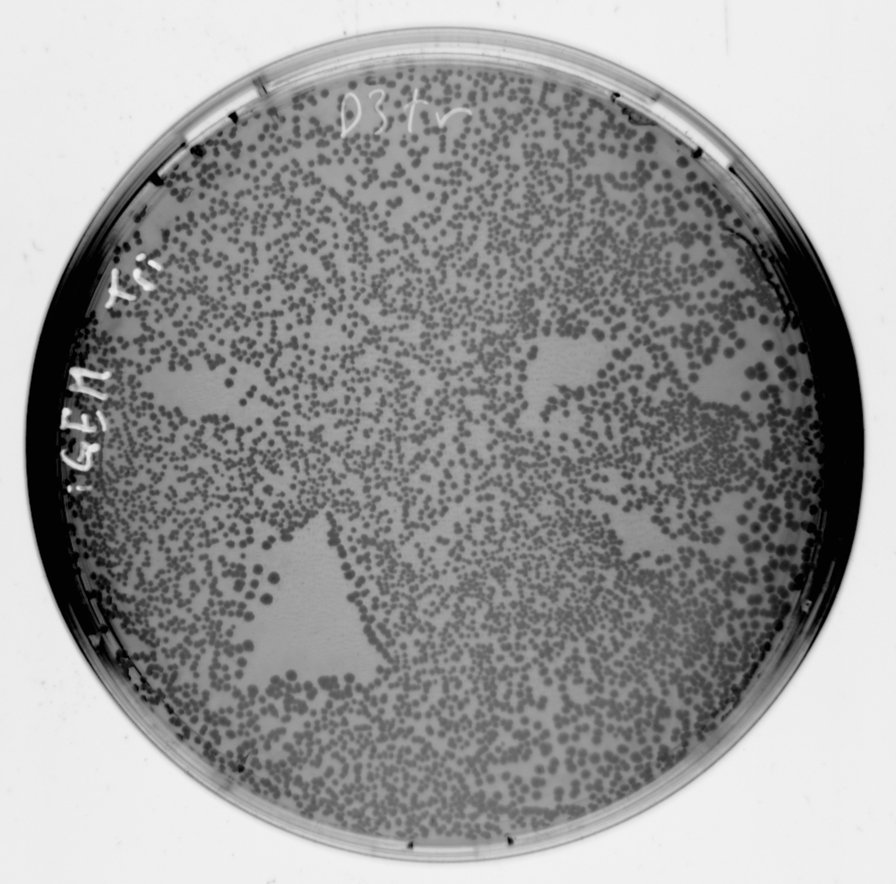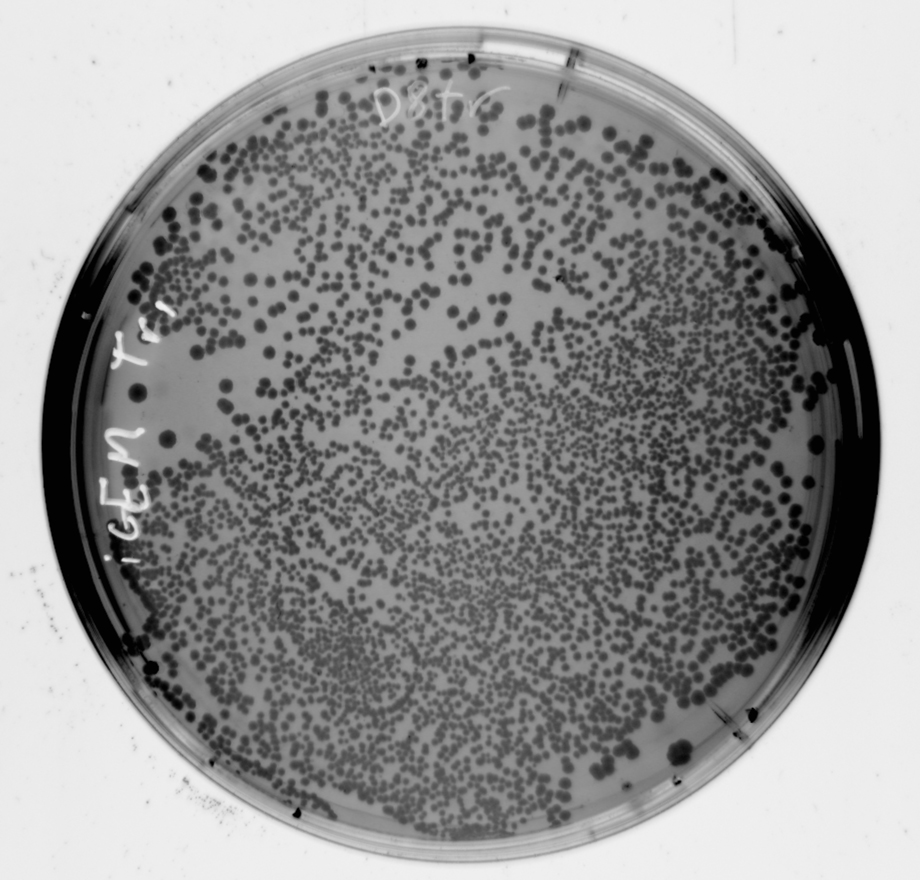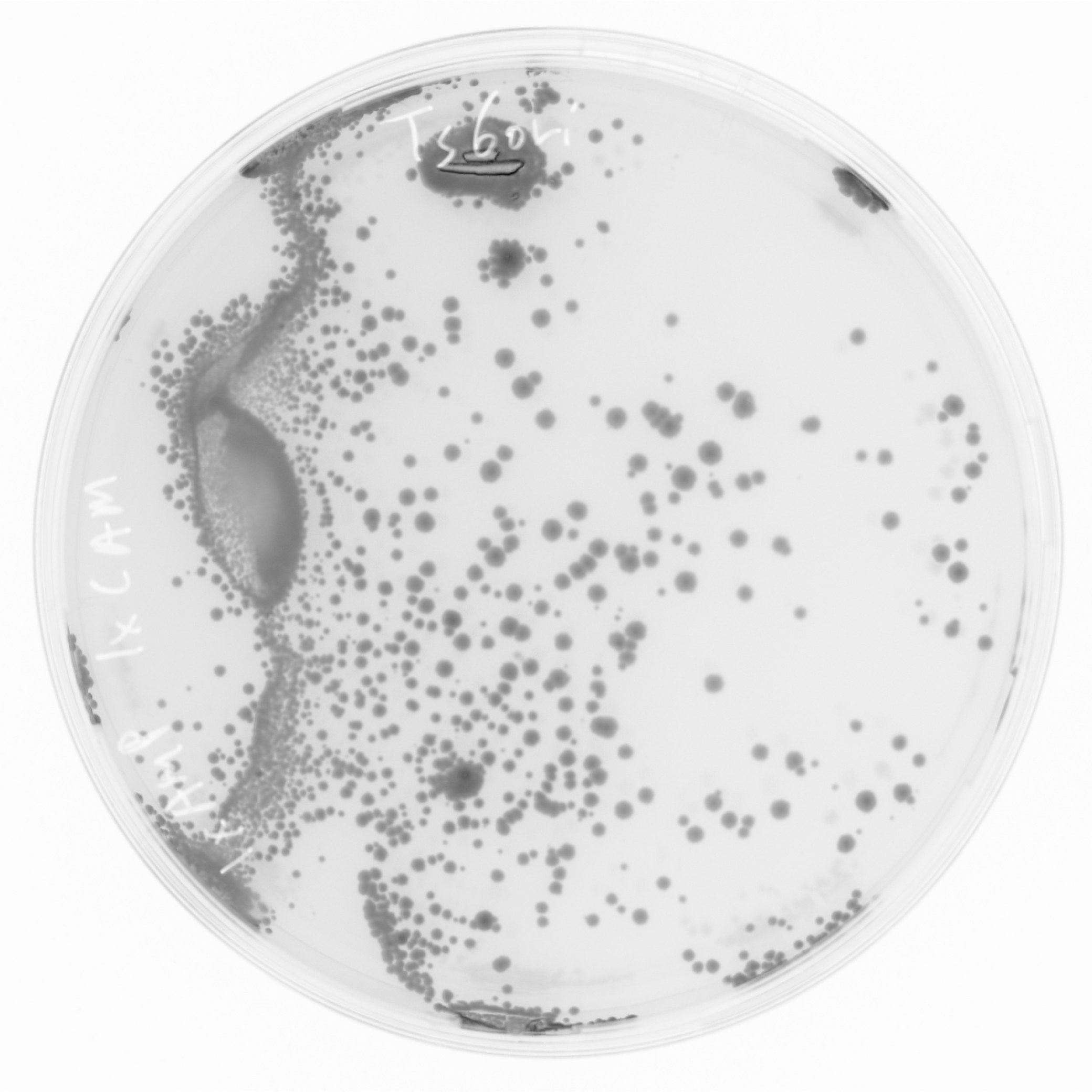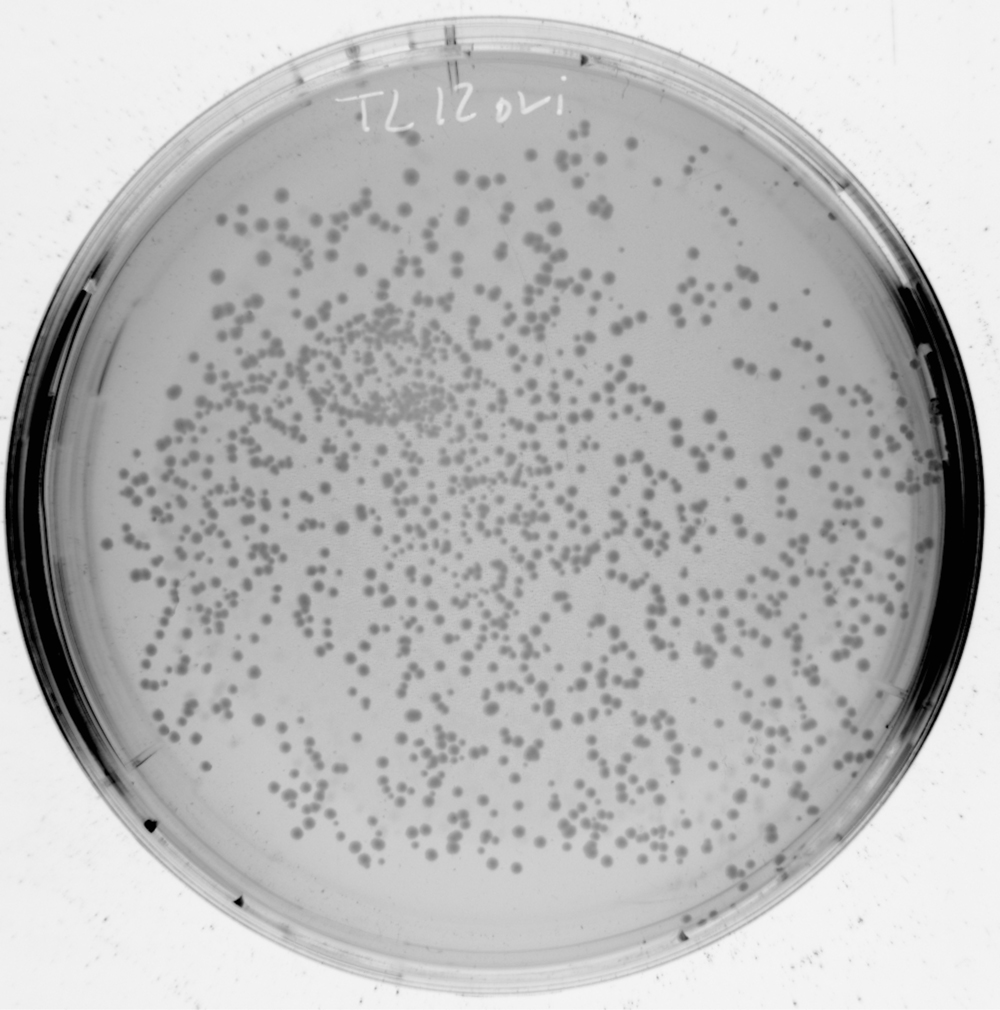Team:TUDelft/Conjugation Results
From 2009.igem.org
| (12 intermediate revisions not shown) | |||
| Line 1: | Line 1: | ||
{{Template:TUDelftiGEM2009_menu_M1_conj}} | {{Template:TUDelftiGEM2009_menu_M1_conj}} | ||
| - | =Conjugation Results= | + | ='''Conjugation Results'''= |
==Verification and Characterization of Wild R751== | ==Verification and Characterization of Wild R751== | ||
| Line 24: | Line 24: | ||
|} | |} | ||
| + | {|border = "0" | ||
| + | |- | ||
| + | |rowspan="4"| | ||
| + | <gallery widths="235px" perrow="2" heights="188px" > | ||
| + | |||
| + | Image:TUDelft-aug5-2009-conj-test-plate-D2-noGFP.jpg|Set 1 Donors 10<sup>-2</sup> dilution plate | ||
| + | |||
| + | Image:TUDelft-aug5-2009-conj-test-plate-T3-GFP.jpg|Set 1 Transconjugants 10<sup>-2</sup> dilution plate | ||
| + | |||
| + | Image:TUDelft-aug5-2009-conj-test-plate-D7-noGFP.jpg|Set 2 Donors 10<sup>-2</sup> dilution plate | ||
| + | |||
| + | Image:TUDelft-aug5-2009-conj-test-plate-T10-GFP.jpg|Set 2 Transconjugants 10<sup>-2</sup> dilution plate | ||
| + | |||
| + | Image:TUDelft-aug5-2009-conj-test-plate-D12-noGFP.jpg|Set 3 Donors 10<sup>-2</sup> dilution plate | ||
| + | |||
| + | Image:TUDelft-aug5-2009-conj-test-plate-T17-GFP.jpg|Set 3 Transconjugants 10<sup>-2</sup> dilution plate | ||
| + | |||
| + | </gallery> | ||
| + | |} | ||
==Verification and Characterization of trbK entry exclusion protein== | ==Verification and Characterization of trbK entry exclusion protein== | ||
| + | A conjugation test was done using our [[Team:TUDelft/ConjugationProtocol | conjugation protocol]] to verify that expression of [http://partsregistry.org/wiki/index.php?title=Part:BBa_K175001 trbK] blocked conjugation. | ||
| + | '''Donors''': [http://www.cbs.knaw.nl/databases/nccb/search_bac_plas.aspx NCCBNr# 2350] cells with R751 (TRI)<br> | ||
| + | '''Receivers''': DH5 α cells expressing [http://partsregistry.org/wiki/index.php?title=Part:BBa_K175001 trbK] (CAM) <br> | ||
| + | '''Transconjugants''': DH5 α cells with R751 and expressing [http://partsregistry.org/wiki/index.php?title=Part:BBa_K175001 trbK] (TRI+CAM)<br> | ||
| + | '''Receivers Control''': DH5 α cells with [http://partsregistry.org/Part:BBa_I13522 I13522] (AMP) <br> | ||
| + | '''Transconjugants Control''': DH5 α cells with R751 and [http://partsregistry.org/Part:BBa_I13522 I13522] (TRI+AMP)<br> | ||
| + | |||
| + | The positive control test used the same donors but different receivers, as detailed above. | ||
| + | |||
| + | The following table shows the calculated conjugation efficiencies (raw data [https://2009.igem.org/Team:TUDelft/19_August_2009#Calin here]): | ||
| + | |||
| + | {| border="1" align="center" | ||
| + | |- align="center" | ||
| + | | Set # || Conjugation Efficinecy | ||
| + | |- align="center" | ||
| + | | trbK 1 || 4.49E-6 | ||
| + | |- align="center" | ||
| + | | trbK 2 || 2.89E-6 | ||
| + | |- align="center" | ||
| + | | control || 0.031 | ||
| + | |- align="center" | ||
| + | |} | ||
| + | |||
| + | |||
| + | [[Image:TUD_aug18_trbK_efficinecy.png|center]] | ||
| + | |||
| + | |||
| + | We can see from this graph that expression of trbK does indeed reduce the conjugation efficiency by four orders of magnitude. With this we have a method to prevent back propagation of the signal and we now have receiver side control over communication. | ||
| + | |||
| + | {|border = "0" | ||
| + | |- | ||
| + | |rowspan="4"| | ||
| + | <gallery widths="235px" perrow="2" heights="188px" > | ||
| + | |||
| + | Image:Conjugation-aug18-trbK_D3tr.jpeg|Set 1 Donors 10<sup>-2</sup> dilution plate | ||
| + | |||
| + | Image:Conjugation-aug18-trbK_T1tr.jpeg|Set 1 Transconjugants 10<sup>0</sup> dilution plate | ||
| + | |||
| + | Image:Conjugation-aug18-trbK_D8tr.jpeg|Set 2 Donors 10<sup>-2</sup> dilution plate | ||
| + | |||
| + | Image:Conjugation-aug18-trbK_T6tr.jpeg|Set 2 Transconjugants 10<sup>0</sup> dilution plate | ||
| + | |||
| + | </gallery> | ||
| + | |} | ||
==Verification and Characterization of Conjugation Testing Plasmid 1== | ==Verification and Characterization of Conjugation Testing Plasmid 1== | ||
| Line 35: | Line 98: | ||
'''Donors''': [http://www.cbs.knaw.nl/databases/nccb/search_bac_plas.aspx NCCBNr# 2350] cells with R751 and [http://partsregistry.org/wiki/index.php?title=Part:BBa_K175005 Conjugation Testing Plasmid 1] (TRI+CAM)<br> | '''Donors''': [http://www.cbs.knaw.nl/databases/nccb/search_bac_plas.aspx NCCBNr# 2350] cells with R751 and [http://partsregistry.org/wiki/index.php?title=Part:BBa_K175005 Conjugation Testing Plasmid 1] (TRI+CAM)<br> | ||
'''Receivers''': DH5 α cells with [http://partsregistry.org/Part:BBa_J23100 J23100] (AMP) <br> | '''Receivers''': DH5 α cells with [http://partsregistry.org/Part:BBa_J23100 J23100] (AMP) <br> | ||
| - | '''Transconjugants | + | '''Transconjugants A''': DH5 α cells with R751 and [http://partsregistry.org/Part:BBa_J23100 J23100] (TRI+AMP)<br> |
| - | '''Transconjugants | + | '''Transconjugants B''': DH5 α cells with [http://partsregistry.org/wiki/index.php?title=Part:BBa_K175005 Conjugation Testing Plasmid 1] and [http://partsregistry.org/Part:BBa_J23100 J23100] (CAM+AMP)<br> |
The following table shows the calculated conjugation efficiencies (raw data [https://2009.igem.org/Team:TUDelft/19_August_2009#Calin here]): | The following table shows the calculated conjugation efficiencies (raw data [https://2009.igem.org/Team:TUDelft/19_August_2009#Calin here]): | ||
| Line 53: | Line 116: | ||
| - | The reason for the lower efficiency of [http://partsregistry.org/wiki/index.php?title=Part:BBa_K175005 Conjugation Testing Plasmid 1] compared to R751 is the presence of the entry exclusion protein trbK. If a receiver cell gets Conjugation Testing Plasmid 1, it can still receive R751 | + | The reason for the lower efficiency of [http://partsregistry.org/wiki/index.php?title=Part:BBa_K175005 Conjugation Testing Plasmid 1] compared to R751 is the presence of the entry exclusion protein trbK. If a receiver cell gets Conjugation Testing Plasmid 1, it can still receive R751 afterward. But if a receiver cell gets R751, it will not accept Conjugation Testing Plasmid 1 afterward because trbK expression will block incoming transfers. |
This test will be redone with R751 ΔoriTR cells once they are available. | This test will be redone with R751 ΔoriTR cells once they are available. | ||
| + | {|border = "0" | ||
| + | |- | ||
| + | |rowspan="4"| | ||
| + | <gallery widths="235px" perrow="2" heights="188px" > | ||
| + | |||
| + | Image:Conjugation-aug18-oriTR_D3oriGFP.jpeg|Set 1 Donors 10<sup>-2</sup> dilution plate | ||
| + | |||
| + | Image:Conjugation-aug18-oriTR_Ts1oriGFP.jpeg|Set 1 Transconjugants B 10<sup>0</sup> dilution plate | ||
| + | |||
| + | Image:Conjugation-aug18-oriTR_tl1.jpeg|Set 1 Transconjugants A 10<sup>0</sup> dilution plate | ||
| + | |||
| + | Image:Conjugation-aug18-oriTR_D8oriGFP.jpeg|Set 2 Donors 10<sup>-2</sup> dilution plate | ||
| + | |||
| + | Image:Conjugation-aug18-oriTR_Ts6oriGFP.jpeg|Set 2 Transconjugants B 10<sup>0</sup> dilution plate | ||
| + | |||
| + | Image:Conjugation-aug18-oriTR_tl7.jpeg|Set 2 Transconjugants A 10<sup>-1</sup> dilution plate | ||
| + | |||
| + | Image:Conjugation-aug18-oriTR_D13oriGFP.jpeg|Set 1 Donors 10<sup>-2</sup> dilution plate | ||
| + | |||
| + | Image:Conjugation-aug18-oriTR_tl12.jpeg|Set 3 Transconjugants A 10<sup>-1</sup> dilution plate | ||
| + | |||
| + | </gallery> | ||
| + | |} | ||
==R751 Gene Knockouts== | ==R751 Gene Knockouts== | ||
| + | The first two knockout attempts [[Team:TUDelft/13_August_2009#Calin | [1]]] [[Team:TUDelft/19_August_2009#Calin | [2]]] failed for both oriTR and trbK knockouts. A third attempt is currently in progress using the [http://www.genebridges.com/gb/details.php?prod_id=K004&main_group=red Quick & Easy Conditional Knock Out Kit - FRT] from Gene Bridges. | ||
| + | |||
| + | [[Team:TUDelft | <<< Back Home]] | ||
{{Template:TUDelftiGEM2009_end}} | {{Template:TUDelftiGEM2009_end}} | ||
Latest revision as of 23:03, 21 October 2009
Conjugation Results
Verification and Characterization of Wild R751
A conjugation test was done using our conjugation protocol to determine wild R751 conjugation efficiency.
Donors: [http://www.cbs.knaw.nl/databases/nccb/search_bac_plas.aspx NCCBNr# 2350] cells with R751 (TRI)
Receivers: DH5 α cells with [http://partsregistry.org/Part:BBa_I13522 I13522] (AMP)
Transconjugants: DH5 α cells with R751 and [http://partsregistry.org/Part:BBa_I13522 I13522] (TRI+AMP)
The following table shows the calculated conjugation efficiencies (raw data here):
| Data Set | Conjugation Efficiency |
| 1 | 0.028 |
| 2 | 0.028 |
| 3 | 0.025 |
|
|
Verification and Characterization of trbK entry exclusion protein
A conjugation test was done using our conjugation protocol to verify that expression of [http://partsregistry.org/wiki/index.php?title=Part:BBa_K175001 trbK] blocked conjugation.
Donors: [http://www.cbs.knaw.nl/databases/nccb/search_bac_plas.aspx NCCBNr# 2350] cells with R751 (TRI)
Receivers: DH5 α cells expressing [http://partsregistry.org/wiki/index.php?title=Part:BBa_K175001 trbK] (CAM)
Transconjugants: DH5 α cells with R751 and expressing [http://partsregistry.org/wiki/index.php?title=Part:BBa_K175001 trbK] (TRI+CAM)
Receivers Control: DH5 α cells with [http://partsregistry.org/Part:BBa_I13522 I13522] (AMP)
Transconjugants Control: DH5 α cells with R751 and [http://partsregistry.org/Part:BBa_I13522 I13522] (TRI+AMP)
The positive control test used the same donors but different receivers, as detailed above.
The following table shows the calculated conjugation efficiencies (raw data here):
| Set # | Conjugation Efficinecy |
| trbK 1 | 4.49E-6 |
| trbK 2 | 2.89E-6 |
| control | 0.031 |
We can see from this graph that expression of trbK does indeed reduce the conjugation efficiency by four orders of magnitude. With this we have a method to prevent back propagation of the signal and we now have receiver side control over communication.
|
|
Verification and Characterization of Conjugation Testing Plasmid 1
A conjugation test was done using our conjugation protocol to verify that [http://partsregistry.org/wiki/index.php?title=Part:BBa_K175005 Conjugation Testing Plasmid 1] was transmitted during conjugation.
Donors: [http://www.cbs.knaw.nl/databases/nccb/search_bac_plas.aspx NCCBNr# 2350] cells with R751 and [http://partsregistry.org/wiki/index.php?title=Part:BBa_K175005 Conjugation Testing Plasmid 1] (TRI+CAM)
Receivers: DH5 α cells with [http://partsregistry.org/Part:BBa_J23100 J23100] (AMP)
Transconjugants A: DH5 α cells with R751 and [http://partsregistry.org/Part:BBa_J23100 J23100] (TRI+AMP)
Transconjugants B: DH5 α cells with [http://partsregistry.org/wiki/index.php?title=Part:BBa_K175005 Conjugation Testing Plasmid 1] and [http://partsregistry.org/Part:BBa_J23100 J23100] (CAM+AMP)
The following table shows the calculated conjugation efficiencies (raw data here):
| Set # | Conjugation Efficiency for Conjugation Testing Plasmid 1 | Conjugation Efficiency for wild R751 |
| 1 | 0.00177 | 0.0141 |
| 2 | 0.00224 | 0.0476 |
| 3 | n/a | 0.0356 |
The reason for the lower efficiency of [http://partsregistry.org/wiki/index.php?title=Part:BBa_K175005 Conjugation Testing Plasmid 1] compared to R751 is the presence of the entry exclusion protein trbK. If a receiver cell gets Conjugation Testing Plasmid 1, it can still receive R751 afterward. But if a receiver cell gets R751, it will not accept Conjugation Testing Plasmid 1 afterward because trbK expression will block incoming transfers.
This test will be redone with R751 ΔoriTR cells once they are available.
|
|
R751 Gene Knockouts
The first two knockout attempts [1] [2] failed for both oriTR and trbK knockouts. A third attempt is currently in progress using the [http://www.genebridges.com/gb/details.php?prod_id=K004&main_group=red Quick & Easy Conditional Knock Out Kit - FRT] from Gene Bridges.
 "
"

